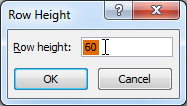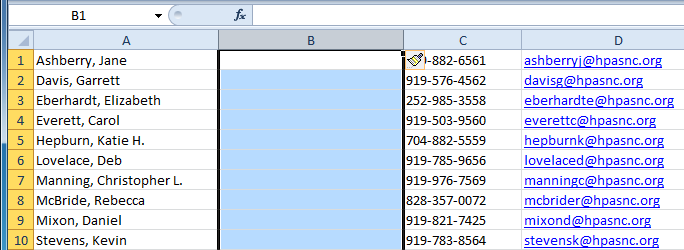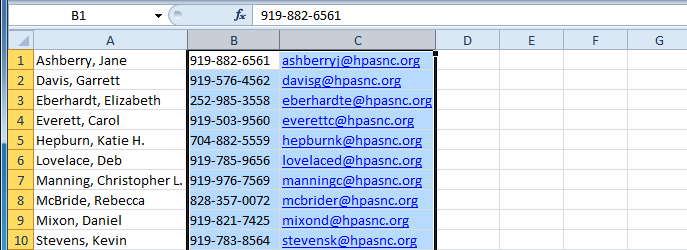Introduction

Working with columns, rows, and cells
Video: Modifying Cells, Rows, and Columns in Excel 2010
Optional: You can download this example for extra practice.
To modify column width:
- Position your mouse over the column line in the column heading so the white cross
 becomes a double arrow
becomes a double arrow  .
.
- Click and drag the column to the right to increase column width or to the left to decrease column width.

- Release the mouse. The column width will be changed in your spreadsheet.

If you see pound signs (#######) in a cell, it means the column is not wide enough to display the cell content. Simply increase the column width to show the cell content.
To set column width with a specific measurement:
- Select the columns you want to modify.
- Click the Format command on the Home tab. The format drop-down menu appears.
- Select Column Width.

- The Column Width dialog box appears. Enter a specific measurement.

- Click OK. The width of each selected column will be changed in your worksheet.
Select AutoFit Column Width from the format drop-down menu, and Excel will automatically adjust each selected column so all of the text will fit.
To modify row height:
- Position the cursor over the row line so the white cross
 becomes a double arrow
becomes a double arrow  .
.
- Click and drag the row downward to increase row height or upward to decrease height.

- Release the mouse. The height of each selected row will be changed in your worksheet.

To set row height with a specific measurement:
- Select the rows you want to modify.
- Click the Format command on the Home tab. The format drop-down menu appears.
- Select Row Height.

- The Row Height dialog box appears. Enter a specific measurement.

- Click OK. The selected rows heights will be changed in your spreadsheet.
Select AutoFit Row Height from the format drop-down menu, and Excel will automatically adjust each selected row so all of the text will fit.
To insert rows:
- Select the row below where you want the new row to appear.

- Click the Insert command on the Home tab.

- The new row appears in your worksheet.

When inserting new rows, columns, or cells, you will see the Insert Options button  by the inserted cells. This button allows you to choose how Excel
formats them. By default, Excel formats inserted rows with the same
formatting as the cells in the row above them. To access more options,
hover your mouse over the Insert Options button and click the drop-down
arrow that appears.
by the inserted cells. This button allows you to choose how Excel
formats them. By default, Excel formats inserted rows with the same
formatting as the cells in the row above them. To access more options,
hover your mouse over the Insert Options button and click the drop-down
arrow that appears.
 by the inserted cells. This button allows you to choose how Excel
formats them. By default, Excel formats inserted rows with the same
formatting as the cells in the row above them. To access more options,
hover your mouse over the Insert Options button and click the drop-down
arrow that appears.
by the inserted cells. This button allows you to choose how Excel
formats them. By default, Excel formats inserted rows with the same
formatting as the cells in the row above them. To access more options,
hover your mouse over the Insert Options button and click the drop-down
arrow that appears.
To insert columns:
- Select the column to the right of where you want the new column to appear. For example, if you want to insert a column between A and B, select column B.

- Click the Insert command on the Home tab.

- The new column appears in your worksheet.

By
default, Excel formats inserted columns with the same formatting as the
column to the left of them. To access more options, hover your mouse
over the Insert Options button and click the drop-down arrow that appears.

When
inserting rows and columns, make sure to select the row or column by
clicking its heading so all of the cells in that row or column are
selected. If you select just a cell in the row or column, only a new
cell will be inserted.
To delete rows:
- Select the rows you want to delete.

- Click the Delete command on the Home tab.

- The rows are deleted from your worksheet.

To delete columns:
- Select the columns you want to delete.

- Click the Delete command on the Home tab.

- The columns are deleted from your worksheet.

Wrapping text and merging cells
If a cell contains more text than can be displayed, you can choose to wrap the text within the cell or merge the cell with empty adjoining cells. Wrap text to make it display on multiple lines of the cell. Merge cells to combine adjoining cells into one larger cell.To wrap text:
- Select the cells with text that you want to wrap.

- Select the Wrap Text command on the Home tab.

- The text in the selected cells will be wrapped in your worksheet.

If you change your mind, reclick the Wrap Text command to unwrap the text.
To merge cells using the Merge & Center command:
- Select the cells you want to merge.

- Select the Merge & Center command on the Home tab.

- The selected cells will be merged, and the text will be centered.

If you change your mind, reclick the Merge & Center command to unmerge the cells.
To access more merge options:
Click the drop-down arrow next to the Merge & Center command on the Home tab. The merge drop-down menu appears.- Merge & Center: Merges selected cells into one cell and centers the text
- Merge Across: Merges each row of selected cells into larger cells; useful when merging content across multiple rows of cells rather than creating one large cell
- Merge Cells: Merges selected cells into one cell
- Unmerge Cells: Unmerges selected cells

Challenge!
- Open an existing Excel 2010 workbook. If you want, you can use this example.
- Modify the size of a column. If you are using the example, make the column that contains board members' names larger.
- Modify the size of a row to be 46 pixels. If you are using the example, modify all the rows that contain text (rows 1-11).
- Insert a column between columns A and B.
- Insert a row between rows 3 and 4.
- Delete a column or row.
- Try merging some cells. If you are using the example, merge the cells in the top or title row (row 1).
- Try using the Text Wrap command on some cells. If you are using the example, wrap the text in the column that contains addresses.













0 comments:
Post a Comment